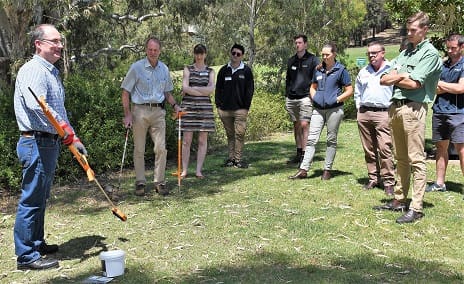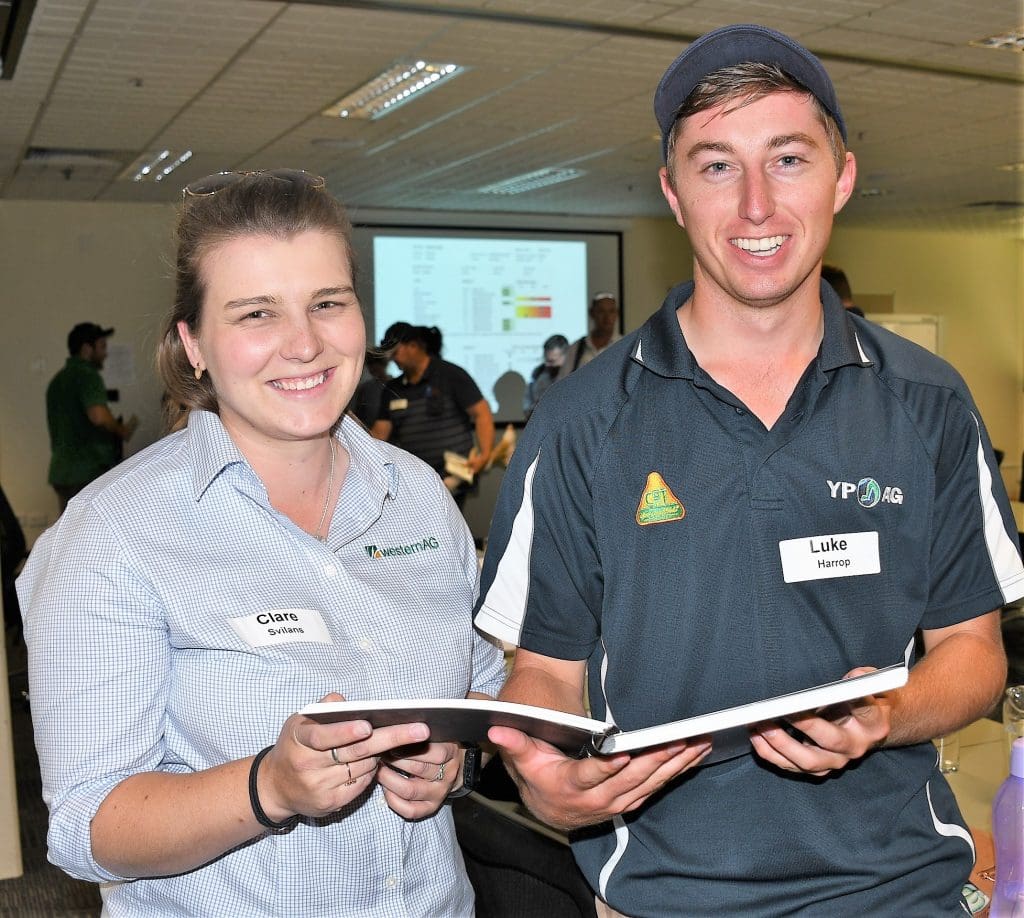
SARDI’s Soil Biology and Molecular Diagnostics group leader, Alan McKay, demonstrating the use of soil sampling probes for soil testing during a PREDICTA B Root Disease Risk Management Course for agronomists at the Waite research precinct in Adelaide (SA). (Photo: GRDC)
GRAIN growers in the southern cropping region who have experienced a dry growing season this year are being warned of a potential increase in the risk of some soilborne diseases in 2019.
Rhizoctonia root rot and crown rot are two cereal diseases likely to pose a problem in parts of South Australia and Victoria where rainfall was below average this year.
A lack of rainfall has reduced the breakdown of cereal stubbles in pulse and oilseed break crops, promoting the risk of disease next season.
Soilborne disease experts, supported by the Grains Research and Development Corporation (GRDC), are advising growers to know their paddocks’ disease risk profile well ahead of sowing in 2019 by having their soils tested through PREDICTA B – the DNA-based soil testing service which enables identification of the pathogens posing the greatest threat to cereal crops.
PREDICTA B is a service provided by the South Australian Research and Development Institute (SARDI), a division of Primary Industries and Regions SA (PIRSA).
SARDI’s Soil Biology and Molecular Diagnostics group leader, Alan McKay, said the risk of disease in 2019 would be heightened where growers decided to sow wheat back into this year’s failed wheat crops.
“I expect rhizoctonia and crown rot will be the main issues as a result of low growing season rainfall, and growers should also keep an eye on cereal cyst nematode as levels have been trending higher over the past five years,” Dr McKay said.
“Rhizoctonia, especially, has a competitive advantage in low moisture situations and its levels have almost certainly increased this year. It survives best when there is no summer rainfall and therefore reduced soil microbial activity.
“If we do experience a dry summer and the break to the season is late, crop seedlings will be exposed to high levels of rhizoctonia next year.”
Rhizoctonia root rot can reduce cereal yields by more than 50 per cent, with barley being the most susceptible.
Dr McKay said the development of the PREDICTA B soil testing service for rhizoctonia had been a success in enabling pathogen levels to be effectively monitored to inform growers’ paddock planning.
Testing for crown rot ahead of sowing in 2019 is also being strongly encouraged.

Attending the PREDICTA B Root Disease Risk Management Course for agronomists at the Waite research precinct in Adelaide (SA) were Clare Svilans, Western AG, Kaniva, Victoria, and Luke Harrop, YP AG, Kadina, SA. (Photo: GRDC)
SARDI research scientist Marg Evans said although crown rot required moisture in autumn to infect the crop, a dry spring such as the one experienced this year would favour expression of the disease.
“The fungus grows quicker in water-stressed plants and in warm weather, and damage is more likely in intensive cereal rotations, especially in durum,” Dr Evans said.
Whiteheads can be symptomatic of crown rot, but given these only appear in seasons with a dry finish, the absence of whiteheads does not indicate freedom from crown rot.
“That is why it is so important to know what is happening in the paddock,” Dr Evans said.
Crown rot survives for up to four years in plant residues/stubbles, and infection occurs when plants come in close contact with infected residues.
Growers and advisers providing soil samples for PREDICTA B testing are urged to include stubble with their samples.
“Sampling strategies are critical – the risk of stubble borne diseases such as crown rot will be underestimated if stubble is not added to the soil sample,” Dr Evans said.
Dr McKay said Australian grain growers incurred, on average, more than $200 million each year in lost production due to cereal root diseases.
“By using PREDICTA B, combined with advice from an accredited agronomist, disease pathogens can be detected and managed before losses occur,” he said.
Source: GRDC
The PREDICTA B service is delivered through SARDI’s Molecular Diagnostic Centre, a state-of-the art facility capable of delivering high throughput diagnostic testing to industry.
Investment in the Molecular Diagnostic Centre and the continued development of PREDICTA B are components of the GRDC-SARDI strategic research partnership.
For more information on PREDICTA B, including access to the soil testing service, go to http://bit.ly/2FyzZpE.
Grain Central: Get our free daily cropping news straight to your inbox – Click here

HAVE YOUR SAY